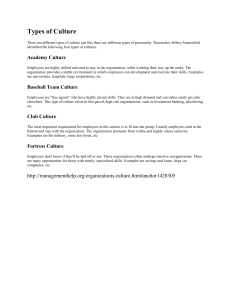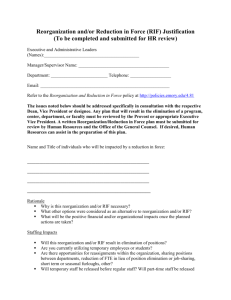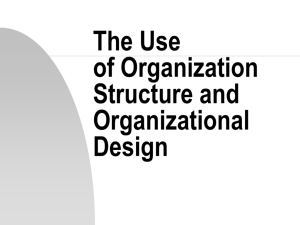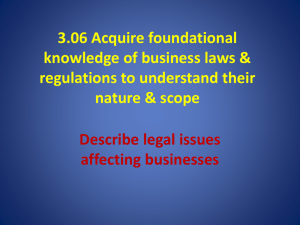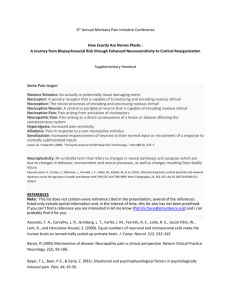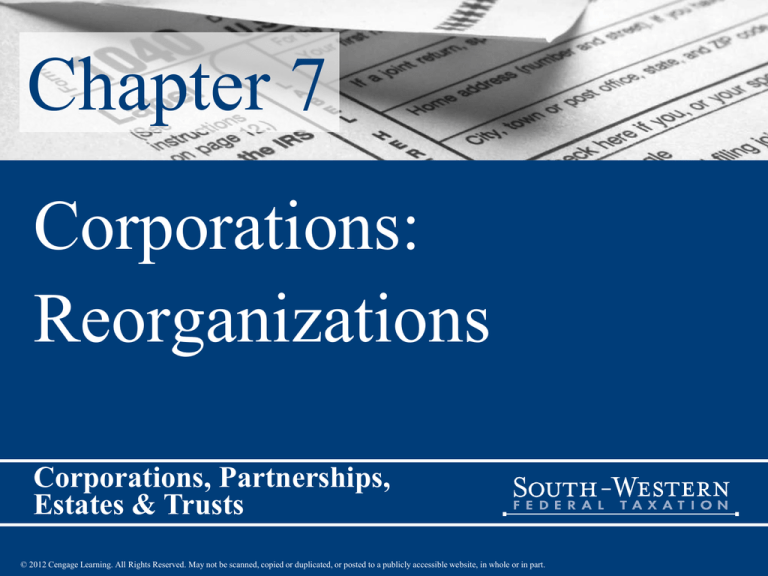
Chapter 7
Corporations:
Reorganizations
Corporations, Partnerships,
Estates & Trusts
© 2012 Cengage Learning. All Rights Reserved. May not be scanned, copied or duplicated, or posted to a publicly accessible website, in whole or in part.
The Big Picture (slide 1 of 3)
• Rock & Water Corporation (R&W) specializes in industrial
park landscaping.
• One of R&W’s central missions is to cause as little negative
impact on the environment as possible.
– Until recently, R&W applied this policy only to its own work, but the
new CEO, Tony Turner, wants to extend this policy to its suppliers.
– R&W is aware that 3 of its suppliers do not use environmentally sound
practices.
• Realizing that simply changing suppliers will not eliminate
these polluting practices,
– R&W is considering acquiring these three suppliers.
– Using this strategy, R&W would control the production practices of
these corporations.
The Big Picture (slide 2 of 3)
• R&W is unsure of how to structure these
potential acquisitions of its suppliers and seeks
your advice.
• R&W gives you the following information
about these potential acquisitions.
– BrineCo is a profitable corporation that has been
owned predominantly by the Adams family since
its incorporation in 1950.
The Big Picture (slide 3 of 3)
– AcidCo started up in 1967.
• AcidCo has been having legal troubles and has continually been
fined since more stringent EPA standards came into existence.
• Besides chemicals used by R&W, AcidCo produces acids for the
mining industry.
– Lastly, ChemCo is a new fertilizer producer with the
technology to produce environmentally safe products.
• Its management is inexperienced, however, and the result has been
inefficiencies in production and unintended harm to its
surroundings.
• ChemCo has yet to show a profit.
• How will you advise R&W to approach each of these
acquisitions?
• Read the chapter and formulate your response.
Reorganizations—In General
• Refers to any corporate restructuring that may
be tax-free under §368
– To qualify, must meet certain general
requirements:
• Must be a plan of reorganization
• Must meet continuity of interest and continuity of
business enterprise tests
• Must have a sound business purpose
• Tax-free status can be denied under step transaction
doctrine
Summary of Different Types
of Reorganizations
• The term reorganization includes:
–
–
–
–
–
–
–
Statutory merger or consolidation
Stock for stock exchange
Stock for assets exchange
Divisive exchange
Recapitalization
Change in identity, form, or place of organization
Transfers in bankruptcy or receivership
Tax Free Reorganization
Consequences, in General (slide 1 of 3)
• Consequences to Acquiring Corporation
– No gain or loss recognized unless it transfers
property to the Target corporation as part of the
transaction
• Then gain, but not loss, may be recognized
– Basis of property received retains basis it had in
hands of Target corp plus any gain recognized by
the target
Tax Free Reorganization
Consequences, in General (slide 2 of 3)
• Consequences to Target Corporation
– No gain or loss unless it retains “other property”
received in the exchange or it distributes its own
property to shareholders
• Other property is defined as anything received other
than stock or securities
– Treated as boot
• Gain, but not loss, may be recognized
Tax Free Reorganization
Consequences, in General (slide 3 of 3)
• Consequences to Target or Acquiring Co.
Shareholders
– No gain or loss unless shareholders receive cash or
other property in addition to stock
• Cash or other property is considered boot
– Gain recognized by the stockholder is the lesser of the boot
received or the realized gain
– Basis of shares received is same as basis of those
surrendered, decreased by boot received, increased
by gain and dividend income, if any, recognized in
the transaction
The Big Picture – Example 4
Gain On Exchange Of Stock (slide 1 of 2)
• Return to the facts of The Big Picture on p. 7-2.
• R&W proceeds with its acquisition of BrineCo.
• Sam acquired a 30% interest in BrineCo 15 years ago for
$80,000.
– He exchanges his BrineCo stock for $25,000 cash and stock in R&W
worth $125,000.
– At the time of the reorganization, BrineCo’s E & P is $50,000.
• Sam has a $70,000 realized gain
– $150,000 cash and stock received - $80,000 BrineCo stock basis.
• Sam has a $25,000 recognized gain (cash boot received).
– The first $15,000 ($50,000 BrineCo E & P X 30%) is taxable as a
dividend, and
– The remaining $10,000 is treated as capital gain.
– Both are taxed at special tax rates.
The Big Picture – Example 4
Gain On Exchange Of Stock (slide 2 of 2)
• Suppose instead that Sam receives 10% of the R&W
stock with a $100,000 fair market value and $50,000
cash.
– If Sam had received solely stock, he would have received
15% of the R&W stock.
– Since Sam owns less than 80% of the stock he would have
owned if solely stock had been distributed (10% ÷ 15% =
67%) and less than 50% of R&W, he qualifies for sale or
exchange treatment under § 302(b)(2).
• Therefore, Sam’s $50,000 recognized gain is a longterm capital gain.
Type A Reorganization
• Includes mergers and consolidations
– Merger is union of two or more corporations
• One corporation retains it existence and absorbs the
others
– Consolidation occurs when a new corporation is
created to take the place of two or more
corporations
Type A Reorganization
(slide 1 of 2)
Type A Reorganization
(slide 2 of 2)
The Big Picture – Example 11
‘‘Type A’’ Reorganization
• Return to the facts of The Big Picture on p. 7-2.
• The Rock & Water Corporation (R&W) formation
occurred as follows.
– Roca and Agua Corporations were united under state law
into new R&W Corporation by transferring all of their
assets to R&W in exchange for all of R&W’s stock.
– By operation of state law, Roca and Agua liquidated by
distributing R&W stock to their shareholders in exchange
for the shareholders’ stock in Roca and Agua.
– This ‘‘Type A’’ reorganization is a consolidation.
Type A Reorganization Issues
(slide 1 of 2)
• Advantages:
– Type A reorganization is flexible
– Consideration need not be voting stock
– Money or other property can be transferred
without disqualifying the transaction, as long as
“continuity of interest” is met
Type A Reorganization Issues
(slide 2 of 2)
• Disadvantages:
– Money or other property transferred is “boot” so
some gain may be required to be recognized
– Shareholders of either entity may dissent; in most
states their shares must be redeemed
– Acquiring entity must assume all liabilities of
Target
Type B Reorganization
(Stock-for-Stock Reorganization)
The Big Picture – Example 12
‘‘Type B’’ Reorganization
• Return to the facts of The Big Picture on p. 7-2.
• R&W Corporation proceeds with the acquisition of
AcidCo.
– In the transaction between R&W and AcidCo shareholders,
20% of R&W voting stock is exchanged for 90% of all
classes of stock in AcidCo.
• The exchange qualifies as a ‘‘Type B’’
reorganization.
• R&W becomes the parent of AcidCo.
Type B Reorganization Requirements
(slide 1 of 4)
• Corporation acquires stock of Target solely in
exchange for its own voting stock (stock for
stock)
– Acquiring corporation must acquire “control”
of Target
• Control is ownership of at least 80% of all classes of
stock of target
• Acquirer may add shares owned previously with shares
acquired in reorganization
Type B Reorganization Requirements
(slide 2 of 4)
• Acquiring corporation may acquire shares
from either:
– (1) Shareholders of Target, or
– (2) Directly from Target
• Exception to the “solely for voting stock”
requirement when shareholders must receive
fractional shares
– May receive cash rather than fractional shares in
the acquiring corporation
Type B Reorganization Requirements
(slide 3 of 4)
• Example: Assume Target has 100 shares
outstanding:
– Acquirer may obtain 80 shares from current Target
shareholders in exchange for Acquirer’s voting
stock
– Target may also issue 400 new shares to Acquirer
in exchange for Acquirer’s voting stock (500
shares would be outstanding)
Type B Reorganization Requirements
(slide 4 of 4)
• Consideration paid by Acquirer can only
include Acquirer’s voting stock or transaction
does not qualify
Type C Reorganization
(Stock-for-Assets Reorganization)
Type C Reorganization Requirements
(slide 1 of 3)
• A ‘‘Type C’’ reorganization is essentially an
exchange of voting stock for assets followed
by liquidation of the target corporation
– Called a “Stock-for-Assets” reorganization
– Transfer is generally between the entities, not the
shareholders
Type C Reorganization Requirements
(slide 2 of 3)
• Consideration paid by Acquirer normally
consists only of voting stock
– However, if at least 80% of FMV of Target is
acquired with voting stock, cash or other property
can be used for remainder
– Limitation: liabilities assumed by Acquirer are
considered “other property” if any additional
“other property” is used
Type C Reorganization Requirements
(slide 3 of 3)
• “Substantially all” of Target’s assets must be
transferred to Acquirer
• There is no statutory definition of
‘‘substantially all’’
– To receive a favorable ruling from the IRS, the
target must transfer at least 90% of net asset value
or 70% of the gross asset value to the acquiring
corporation
The Big Picture – Example 14
‘‘Type C’’ Reorganization
• Return to the facts of The Big Picture on p. 7-2.
• R&W Corporation proceeds with the acquisition of ChemCo.
– R&W transfers voting stock representing a 30% ownership interest to
ChemCo for substantially all of ChemCo’s assets.
– After the exchange, ChemCo’s only assets are cash and R&W voting
stock.
– ChemCo distributes the R&W stock and cash to its shareholders in
exchange for their ChemCo stock.
• The exchange qualifies as a ‘‘Type C’’ reorganization if
ChemCo liquidates after the distribution.
• The exchange is taxable to the shareholders to the extent of the
cash they received.
Type D Reorganization
(slide 1 of 4)
• Generally a mechanism for corporate division
– Called a “divisive reorganization” but can be used
to carry out a corporate combination
– In a Type D acquisitive reorganization
• Entity transferring assets is considered the acquiring
corporation
• Corporation receiving the property is the target
Type D Reorganization
(slide 2 of 4)
• In an acquisitive Type D reorganization
– Substantially all of acquiring corp’s property must
be transferred to target corporation
– The acquiring corp must be in control (at least
50%) of the target
– Target stock received by the acquiring corp and
any remaining assets of acquiring corp must be
distributed to its shareholders
– Acquiring corporation must liquidate
Type D Reorganization
(slide 3 of 4)
• In a divisive Type D reorganization
– A corporation is divided
– One or more new corps are formed to receive
assets of original corp
– Original corp must receive stock representing
control (80%) of new corps
– Stock of new corps is then distributed to
shareholders of original corp
Type D Reorganization (slide 4 of 4)
• Three types of divisive “Type D”
reorganizations
– Spin-Off and Split-Off
• A new corporation is formed to receive some of the
assets of the original corporation in exchange for the
new corporation's stock
– Split-Up
• Two or more corporations are formed to receive
substantially all of the assets of the original corporation
Type D Reorganization Spin-Off
(slide 1 of 2)
Type D Reorganization Spin-Off
(slide 2 of 2)
Type D Reorganization Split-Off
(slide 1 of 2)
Type D Reorganization Split-Off
(slide 2 of 2)
Type D Reorganization Split-Up
(slide 1 of 2)
Type D Reorganization Split-Up
(slide 2 of 2)
The Big Picture – Example 23
‘‘Type D’’ Split-up (slide 1 of 2)
• Return to the facts of The Big Picture on p. 7-2.
• R&W Corporation proceeds with its acquisition of
AcidCo.
• Gail and Gary are equal shareholders of AcidCo,
which was organized six years ago.
• To prepare for the restructuring transaction with
R&W, AcidCo creates two new corporations to
receive its business lines.
– AbraseCo will receive all of the assets related to the
landscaping chemical business.
• These are the assets desired by R&W.
– The remaining mining acid assets are transferred to
MineCo.
The Big Picture – Example 23
‘‘Type D’’ Split-up (slide 2 of 2)
• The AbraseCo and MineCo stock received in
exchange for AcidCo’s assets is transferred equally to
Gary and Gail in exchange for all of their shares in
AcidCo.
– Gail and Gary now are 100% owners of both AbraseCo
and MineCo.
• Having no assets, AcidCo liquidates.
• This transaction qualifies as a ‘‘Type D’’ split-up.
– Neither Gary nor Gail recognizes any gain or loss on the
exchange.
– Gary and Gail take a basis in the AcidCo stock equal to
their basis in the stock of AbraseCo and MineCo.
– The allocation between AbraseCo and MineCo is
performed in the manner utilized in Examples 21 and 22.
Type E Reorganization
(slide 1 of 2)
• Type E reorganization is a recapitalization
– Involves a major change in character and amount
of outstanding stock, securities, or paid-in-capital
• The following exchanges qualify:
– Bonds for stock
– Stock for stock
– Bonds for bonds
Type E Reorganization
(slide 2 of 2)
• Corporation can exchange its common stock
for preferred stock or its preferred stock for
common stock tax-free
– The exchange of bonds for other bonds is tax-free
when the debt received has a principal amount that
is not more than the surrendered debt’s principal
amount
The Big Picture – Example 25
‘‘Type E’’ Reorganization
• Return to the facts of The Big Picture on p. 7-2.
• BrineCo’s stock is owned 80% by Gomez Adams and
20% by his children.
– Gomez wants to relinquish his corporate control to his
children.
• He exchanges his common voting stock for nonvoting
preferred stock.
• The exchange qualifies as a ‘‘Type E’’
reorganization.
– However, any difference in value between stock received
and stock surrendered could be treated as compensation to
Gomez or as a gift to Gomez’s children.
Type F Reorganization
• A mere change in identity, form, or place of
organization, however effected
– Restricted to a single operating corporation
– Tax characteristics of predecessor corp carry over
to successor corp
– Does not jeopardize status of §1244 stock or
terminate a valid S corp election
Type G Reorganization
• Substantially all of the assets of debtor corp
are transferred to an acquiring corp in
exchange for its stock and securities
– This stock and securities are distributed to the
senior creditors in exchange for their claims
against the debtor corporation
Judicial Doctrines
(slide 1 of 2)
• Besides meeting specific requirements of
reorganization, several judicially created
doctrines must be met
– Reorganization must exhibit a sound business
purpose
• Not a well defined test
– Continuity of interest test
• IRS deems this test met if shareholders of Target
receive stock in Acquirer equal to at least 40% of their
prior stock ownership in Target stock
Judicial Doctrines
(slide 2 of 2)
– Continuity of business enterprise test
• Requires the acquiring corp to either:
– Continue the Target’s historic business, or
– Use a significant portion of Target’s assets in business
– Step transaction doctrine
• Ensures that a series of transactions are not used to
obtain tax benefits that would be unavailable if the
transaction were accomplished in a single step
• IRS generally views any transactions occurring within
one year of reorganization as part of the restructuring
Carryover of Corporate
Tax Attributes (slide 1 of 4)
• Assumption of liabilities
– Acquiring corp either assumes liabilities of Target
or takes property subject to liabilities
• Allowance of Carryovers
– In Type A, C, acquisitive D, and G
reorganizations, the Target’s tax attributes are
acquired
– In Type B, E, and F reorganizations, Target
corporation remains intact and retains its tax
attributes
Carryover of Corporate
Tax Attributes (slide 2 of 4)
• NOL Carryovers
– Amount of NOL that can be used in year
ownership change occurs is limited to a percentage
representing the remaining days in the tax year
over the total number of days in the year
Carryover of Corporate
Tax Attributes (slide 3 of 4)
• NOL Carryovers (cont’d)
– NOL can be further limited in first and succeeding years
when there is a more than 50-percentage-point ownership
change
• An ownership change takes place on the day (change date) that
either an equity structure shift or an owner shift occurs
– An equity structure shift occurs when a tax-free reorganization causes
an owner shift
– An owner shift is any change in the common stock ownership of
shareholders owning at least 5%
– NOL can be used to the extent of the value of the loss
corp’s stock on the date of the ownership change multiplied
by the long-term tax-exempt rate
Carryover of Corporate
Tax Attributes (slide 4 of 4)
• Earnings and Profits
– Positive E & P of acquired corp carries over
– E & P of a deficit corp is deemed received by
acquiring corp as of change date
• Deficit may only be used to offset E & P accumulated
by successor corporation after the change date
The Big Picture – Example 33
Net Operating Loss Carryovers
• Return to the facts of The Big Picture on p. 7-2.
• R&W Corporation proceeds with its acquisition of ChemCo.
• Prior to the merger, ChemCo accumulated a $3 million NOL.
• After the reorganization, R&W generates $5 million of taxable
income.
– ChemCo’s $3 million NOL carries over to offset the $5 million taxable
income, reducing it to $2 million.
– R&W saves $1,020,000 in Federal income taxes by being able to utilize
ChemCo’s NOL carryover ($3 million NOL carryover X 34%).
• Thus, the $3 million NOL is a valuable asset that may be
worth more than $1 million to R&W.
The Big Picture – Example 41
Carryovers Limited By § 382 (slide 1 of 2)
• Return to the facts of The Big Picture on p. 7-2.
• R&W Corporation proceeds with the acquisition of
ChemCo.
– It acquires $100,000 of general business credits from
ChemCo.
• Assume that the § 382 limitation for the year is
$200,000.
– R&W’s taxable income is $800,000 before applying this
limitation.
• If the full deduction allowable by § 382 were utilized,
R&W’s taxable income would be $600,000
($800,000 - $200,000).
The Big Picture – Example 41
Carryovers Limited By § 382 (slide 2 of 2)
• The amount of general business credit that
R&W may take in the current year is $68,000,
computed as follows.
Step 1. Regular tax liability
($800,000 X 34% tax rate)
$272,000
Step 2. Tax liability with full § 382
limitation ($600,000 X 34% tax rate) 204,000
Step 3. Subtract step 2 from step 1
$ 68,000
Comparison of Reorganization Types
(slide 1 of 5)
Comparison of Reorganization Types
(slide 2 of 5)
Comparison of Reorganization Types
(slide 3 of 5)
Comparison of Reorganization Types
(slide 4 of 5)
Comparison of Reorganization Types
(slide 5 of 5)
Refocus On The Big Picture (slide 1 of 6)
• Rock & Water Corporation (R&W) is unsure how to structure
the potential acquisitions of its three suppliers.
• The first target is BrineCo, a profitable corporation that has
been owned predominantly by the Adams family since its
incorporation in 1950.
• In negotiations with BrineCo, R&W determines that
– BrineCo has virtually no debt,
– Senior Adams family members are ready to retire, and
– The younger generation has no interest in the business.
• Consequently, all members would like some cash in the
transaction.
Refocus On The Big Picture (slide 2 of 6)
• The ‘‘Type A’’ reorganization would be a good
choice for this acquisition.
– R&W can exchange cash, preferred stock, and voting stock
for only those assets it wants to acquire.
• Since BrineCo has few liabilities, acquiring all of
them will not be an issue nor will obtaining the
approval of the BrineCo shareholders.
• The assets not transferred to R&W will be distributed
to the Adams family, along with the stock and cash
received from R&W in complete liquidation of
BrineCo.
Refocus On The Big Picture (slide 3 of 6)
• The next target, AcidCo, has been struggling financially and
has legal liability issues related to its failure to meet
environmental standards.
• Its landscaping chemical and mining acid lines of business are
active and have been in existence for more than five years,
– AcidCo can, through a divisive ‘‘Type D’’ reorganization, spin off or
split off its mining acid business and retain the landscaping chemical
line.
• Once this is accomplished, R&W can acquire AcidCo stock
from its shareholders by exchanging R&W voting stock in a
‘‘Type B’’ reorganization.
– This restructuring would protect R&W’s assets from AcidCo’s legal
liability issues until R&W can clean up the environmental problems.
Refocus On The Big Picture (slide 4 of 6)
• Lastly, ChemCo has the technology to produce
environmentally safe products, but its inexperienced
management has resulted in it being unprofitable.
• R&W can use a ‘‘Type C’’ reorganization to acquire
substantially all of ChemCo’s assets and can select
which liabilities it assumes.
– To avoid having the liability assumption treated as boot,
R&W should use solely voting stock for the exchange.
• ChemCo must terminate after the reorganization.
Refocus On The Big Picture (slide 5 of 6)
• ChemCo has NOL, capital loss, and business
credit carryovers
– R&W must be sure to meet the continuity of
business enterprise requirement for at least two
years.
• Most likely the § 382 limitation will apply
– ChemCo shareholders will experience an equity
structure shift of greater than 50 percentage points.
– Thus, the amount of carryover tax attributes that
R&W may use in any one year will be limited.
Refocus On The Big Picture (slide 6 of 6)
• A net present value analysis should be
performed to determine what R&W is willing
to pay for ChemCo’s tax attributes.
• Finally R&W will need to keep two E & P
accounts.
– One for its pre-reorganization E & P, and
– Another with ChemCo’s negative E & P that will
be offset by future profits of the combined
company.
If you have any comments or suggestions concerning this
PowerPoint Presentation for South-Western Federal
Taxation, please contact:
Dr. Donald R. Trippeer, CPA
trippedr@oneonta.edu
SUNY Oneonta
© 2012 Cengage Learning. All Rights Reserved. May not be scanned, copied or duplicated, or posted to a publicly accessible website, in whole or in part.
66

